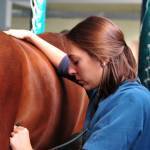Will Your Hospitalized Horse Survive Diarrhea?

If your horse is ever hospitalized for colitis (diarrhea), the good news is that there is a 76% chance of survival. If it develops laminitis, however, the chance of survival plummets to 50%. Survival can further be predicted based on blood L-lactate and creatinine, as well as the presence of systemic inflammatory response syndrome (SIRS).
This information was generated from data collected in a study involving 1,438 diarrheic horses treated at 26 institutions located in 14 countries throughout the world.*
Euthanasia was performed in 306 of the 1,438 horses, including 176 that were euthanized because of perceived poor prognosis. Of those, 14% were diagnosed with laminitis.
“In total, laminitis was diagnosed in 100 horses (7%) of the population, which was low compared to other studies. However, some hospitals included in this study had no or few laminitis cases, whereas other hospitals had a prevalence of 25%,” said Kathleen Crandell, Ph.D., a nutritionist with Kentucky Equine Research.
In terms of predicting survival, the research team found that elevated L-lactate and creatinine blood levels were associated with higher odds of euthanasia. High levels of those analytes in the bloodstream indicate the presence of organ injury/failure and cardiovascular deficiencies.
Researchers identified SIRS as another risk factor for death. SIRS was defined as horses having two or more of the following: heart rate of more than 40 beats per minute, respiratory rate over 20 breaths per minute, body temperature above 38.5° C (101.3° F) or less than 36.5° C (97.7° F), and a white blood cell count less than 5,300 or greater than 18,800 cells/microliter.
Sixty-six percent of the diarrheic horses were classified as meeting SIRS criteria.
Combining SIRS, L-lactate, and creatinine, the research team found that SIRS horses with L-lactate values (over 2.9 millimole/liter) had a survival of only 59% compared to the 81% of horses with SIRS and lower L-lactate levels (less than 2.9 millimole/liter). Similarly, horses with both SIRS and high creatinine concentrations (greater than 159 micromole/liter) had a survival rate of only 55% compared to 81% of horses with SIRS and low creatinine concentrations (less than 159 micromole/L).
“Assigning a SIRS score and measuring L-lactate and creatinine are easy and inexpensive, and will help identify diarrheic horses at risk of dying,” Crandell said.
While infection does play a role in colitis, a causative agent (pathogen) is not always identified, and other causes of diarrhea exist. In this study, an infectious agent suspected to be the cause of colitis was only identified in 16% of cases. This means that other causes of diarrhea should be considered, such as antibiotic-associated diarrhea or secondary to dietary changes and shifts in the intestinal microbiome.
“Changes in the pH of the hindgut due to alterations in the microbial populations and acid profiles can put affected horses at higher risk for colic and laminitis. EquiShure is a research-proven supplement that uses time-released technology to deliver a buffer to the hindgut to maintain appropriate pH and stabilize the microbiome,” explained Crandell.
*Gomez, D.E., B. Dunkel, D.L. Renaud, L.G. Arroyo, A. Schoster, J.J. Kopper, D. Byrne, MEDS Group, and R.E. Toribio. 2023. Survival rates and factors associated with survival and laminitis of horses with acute diarrhoea admitted to referral institutions. Equine Veterinary Journal. doi:10.1111/evj.14032.








